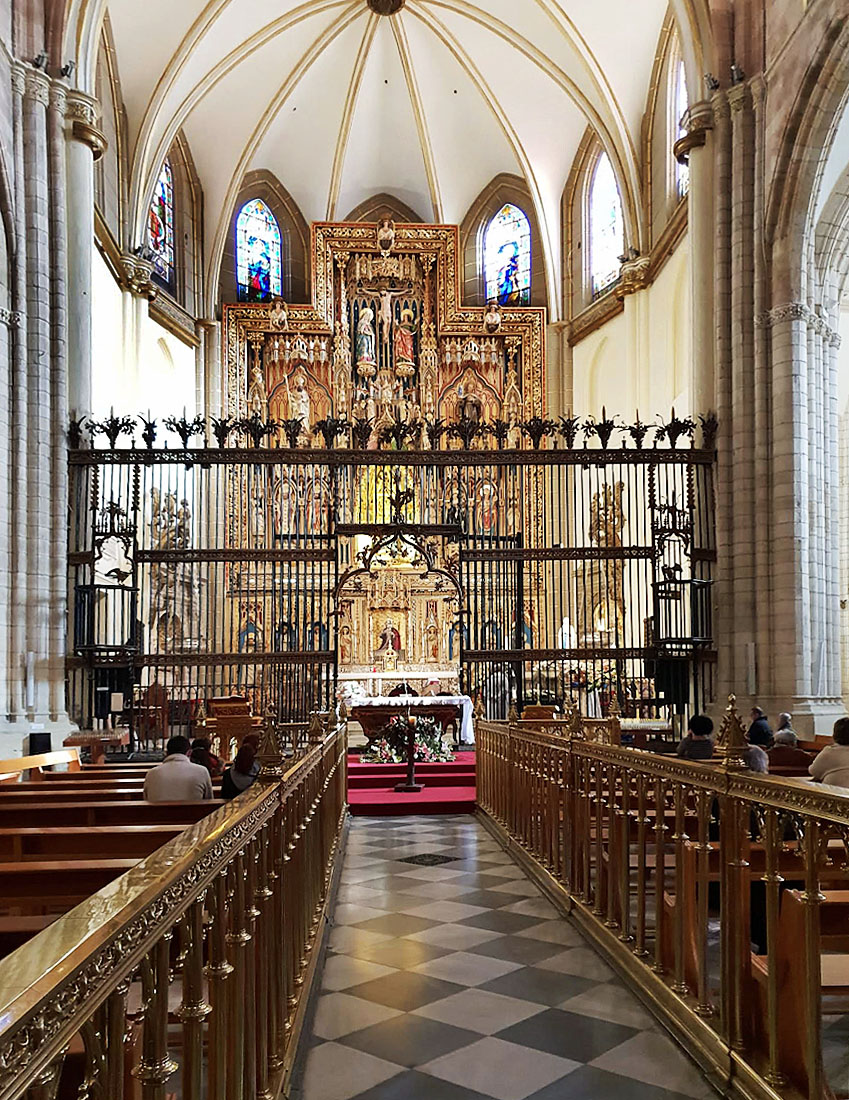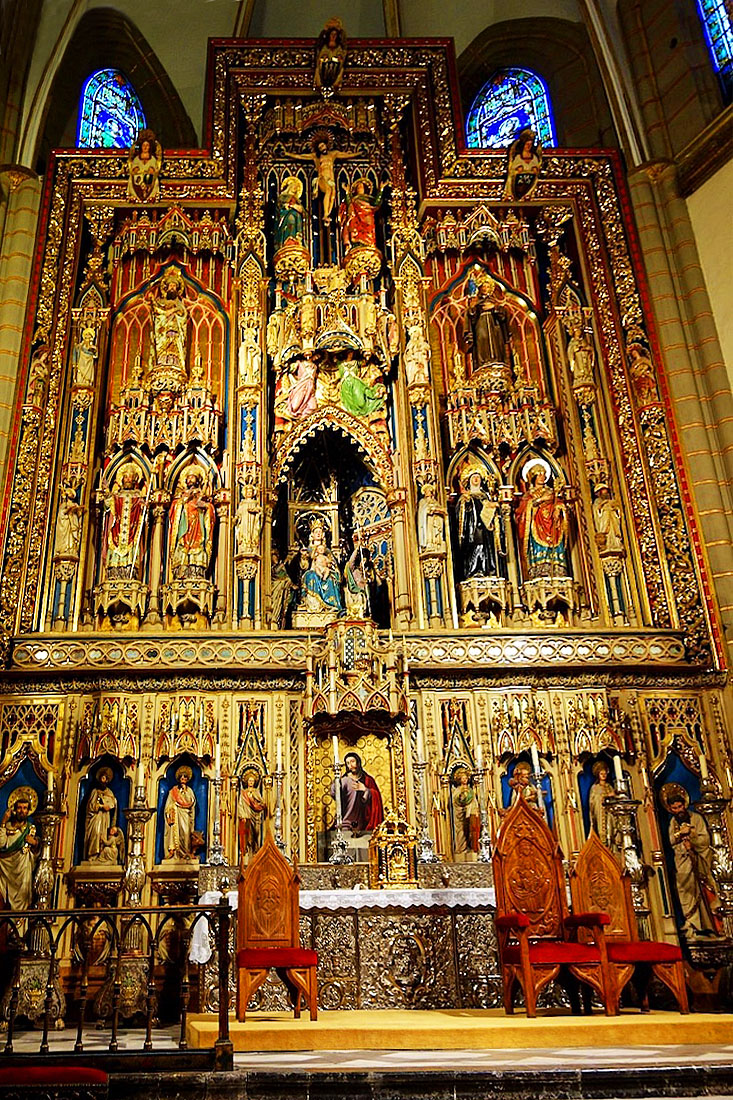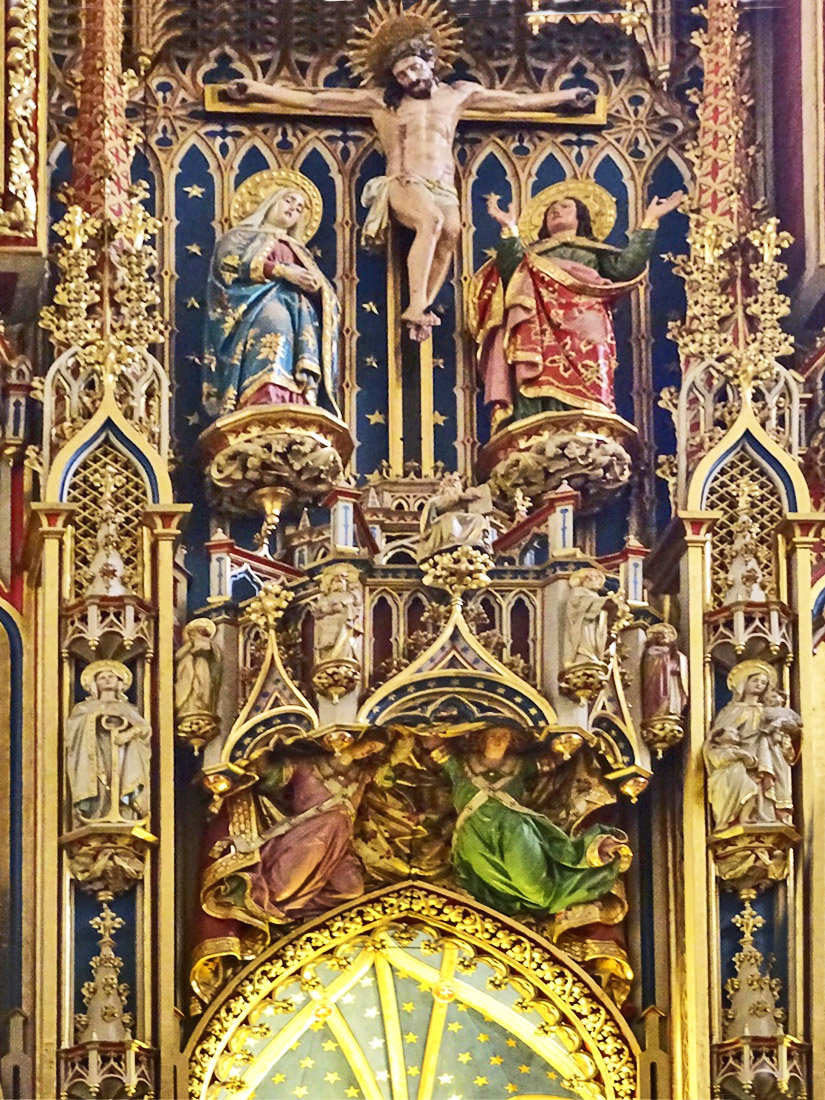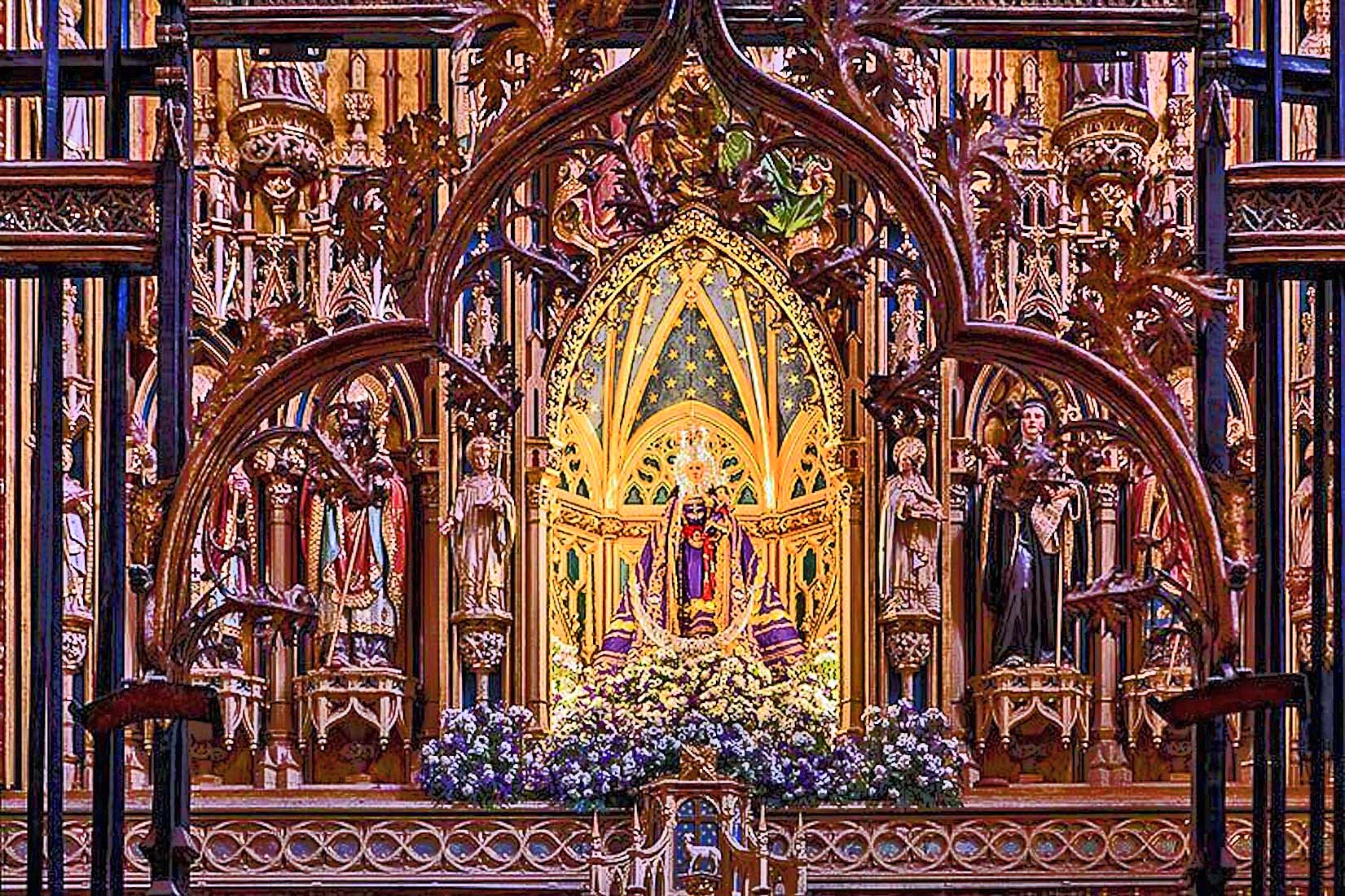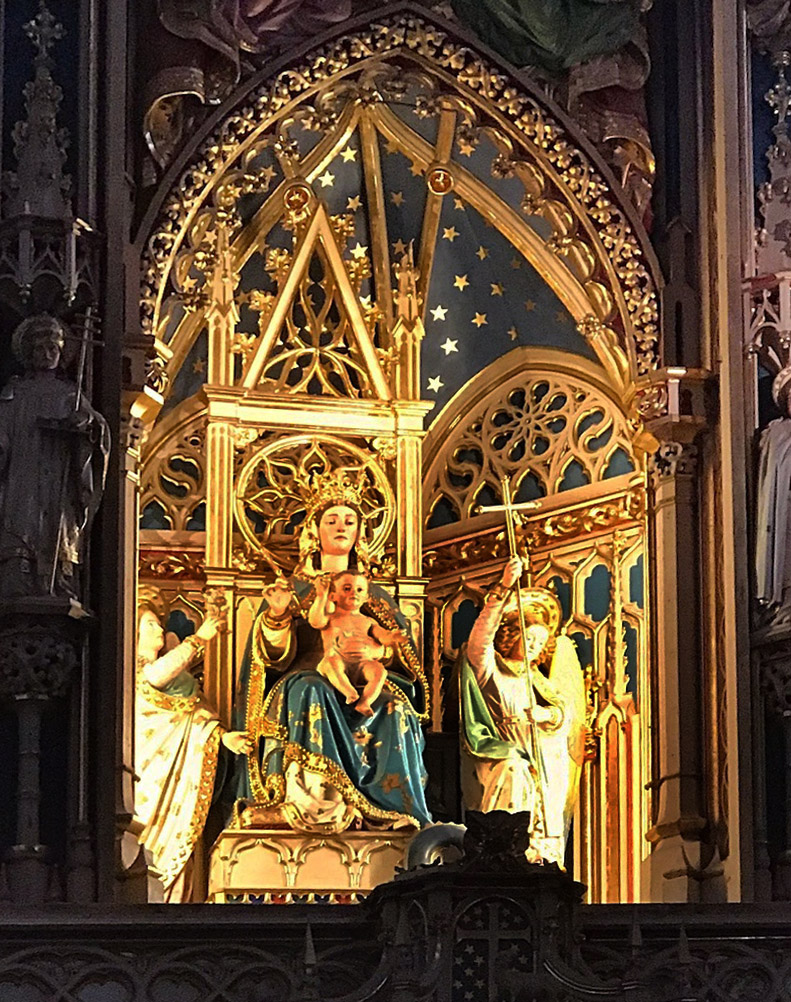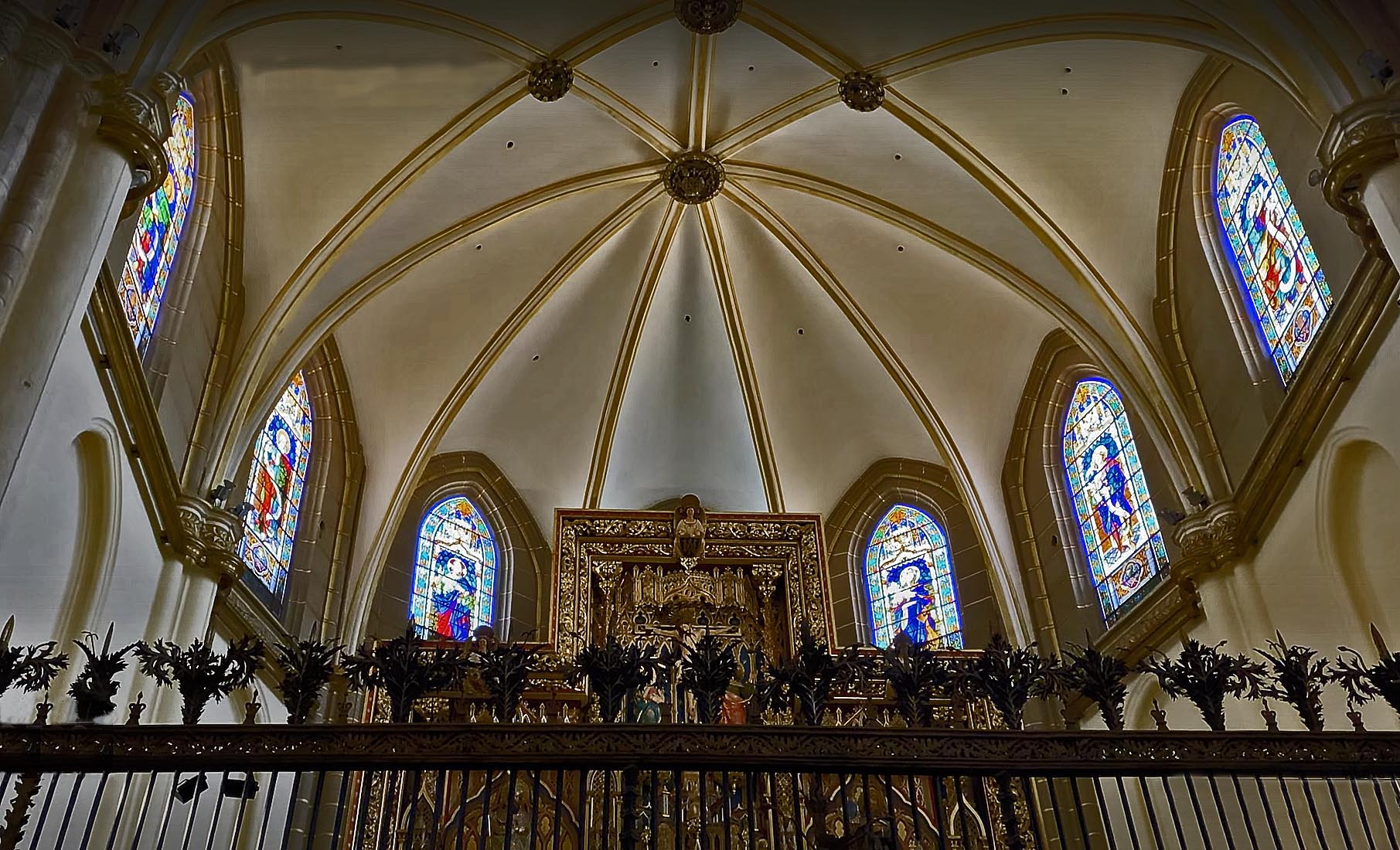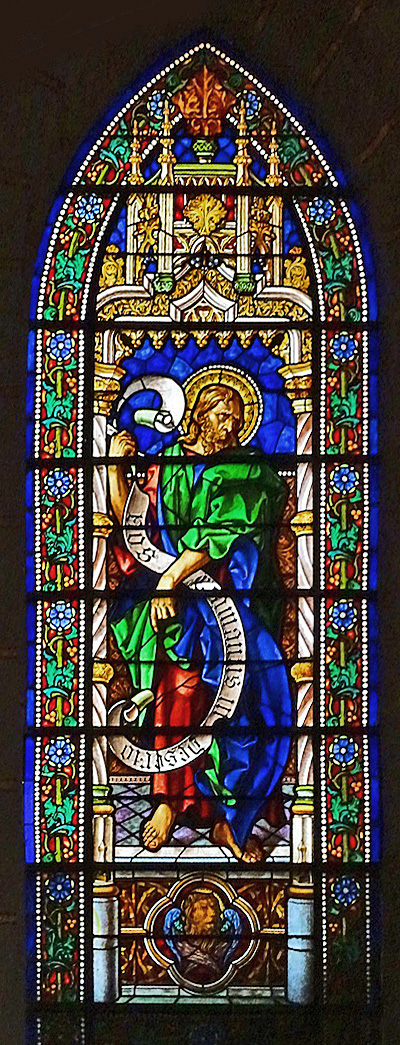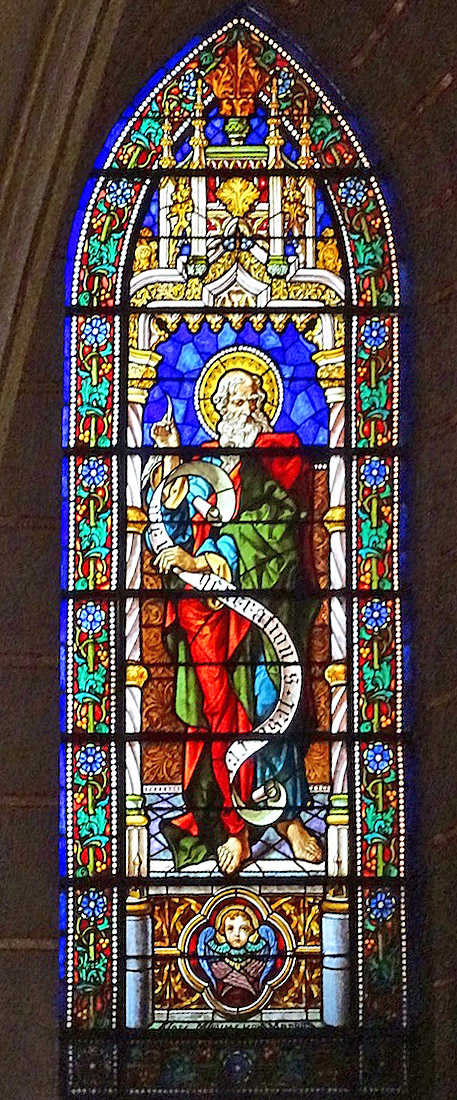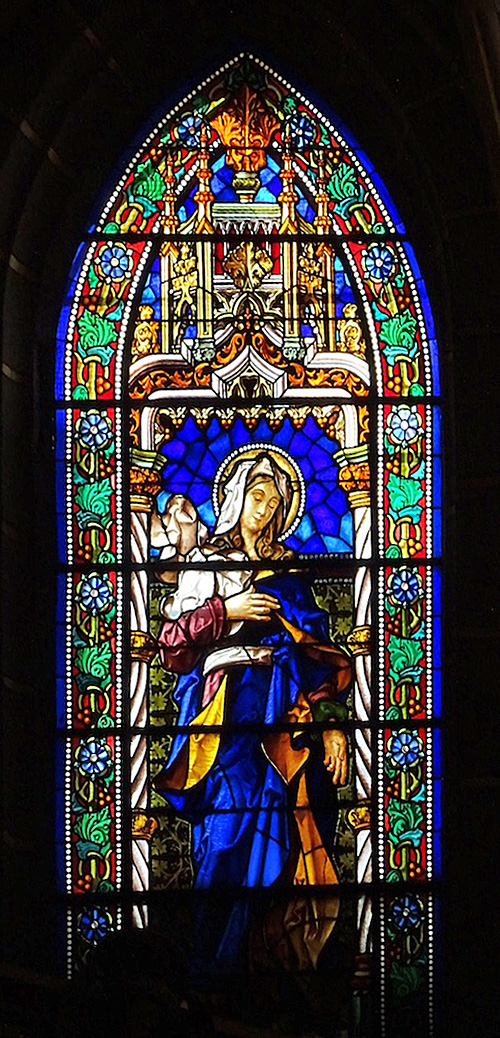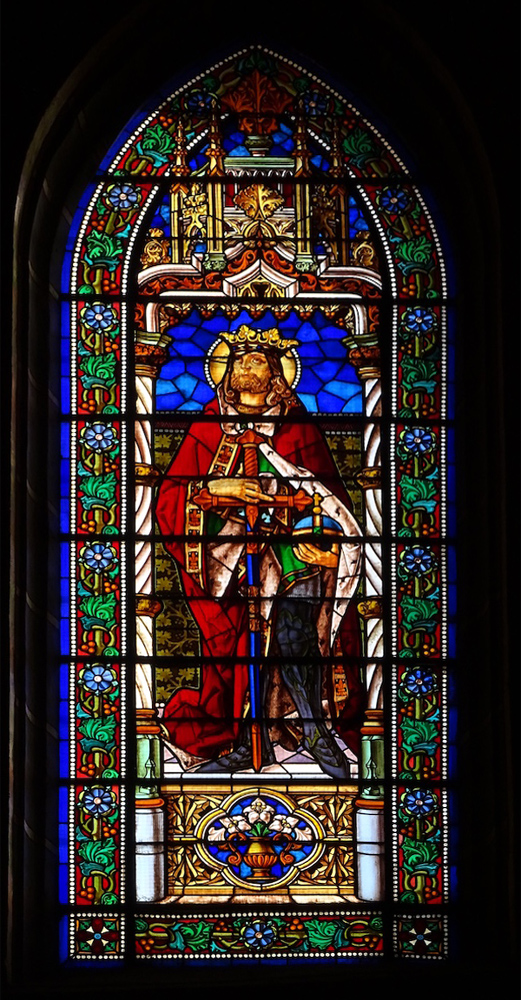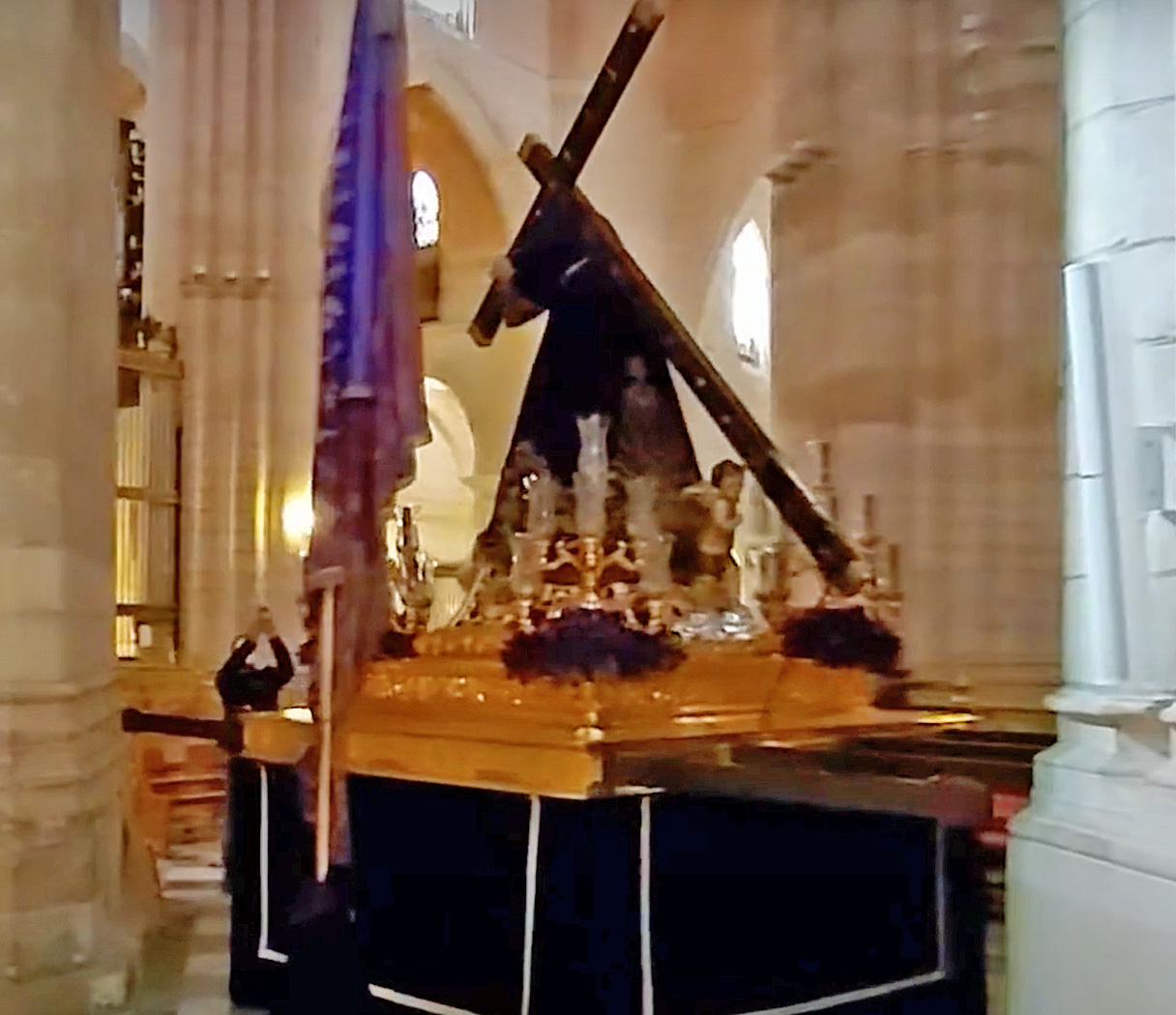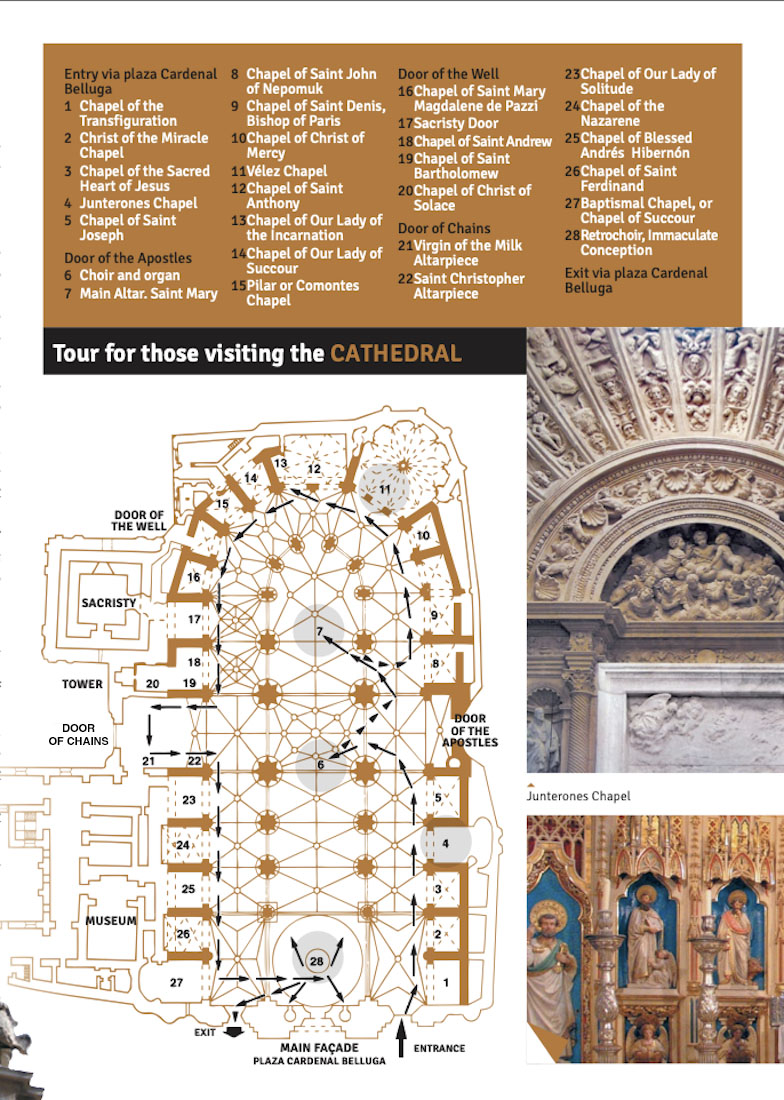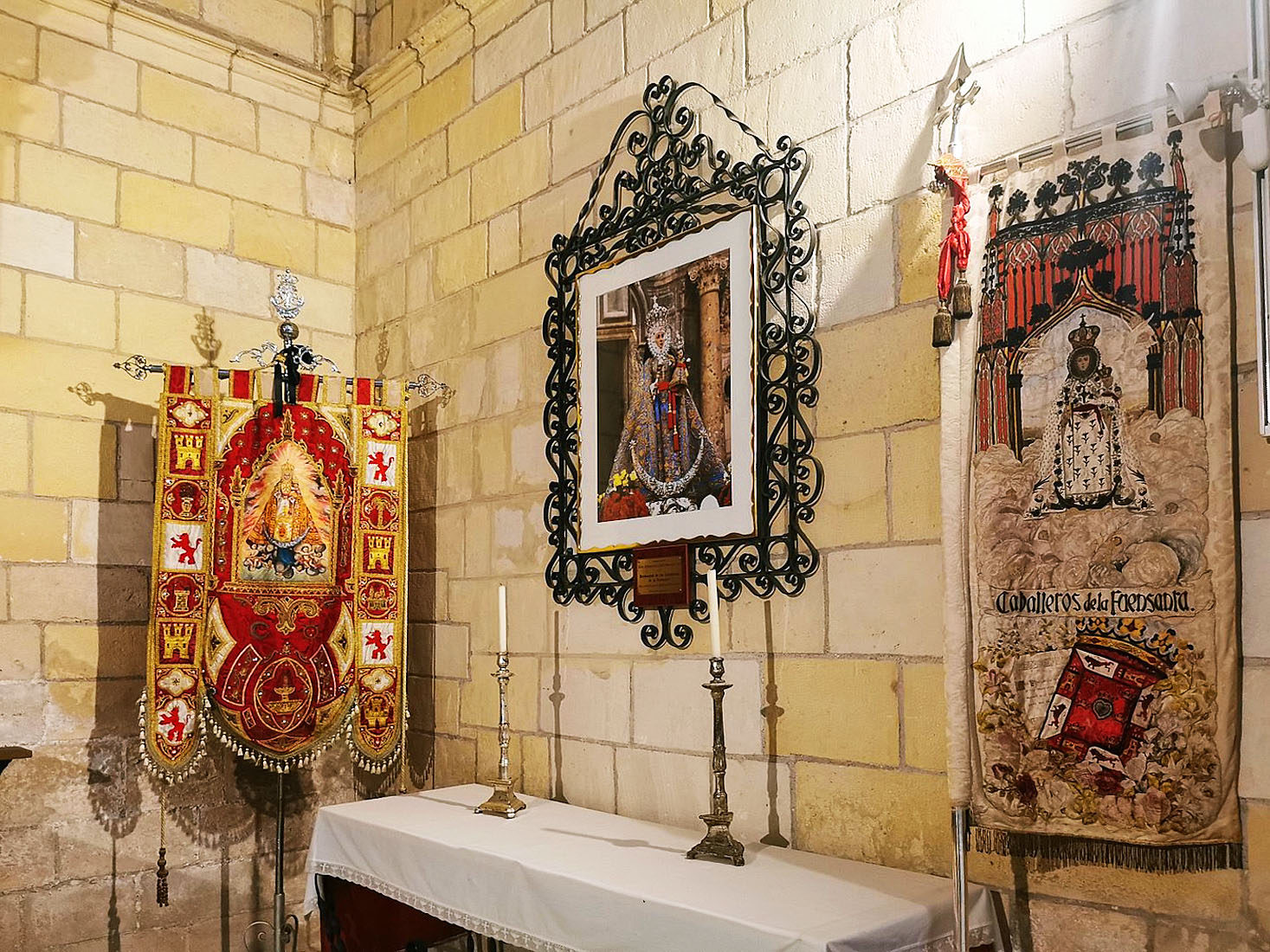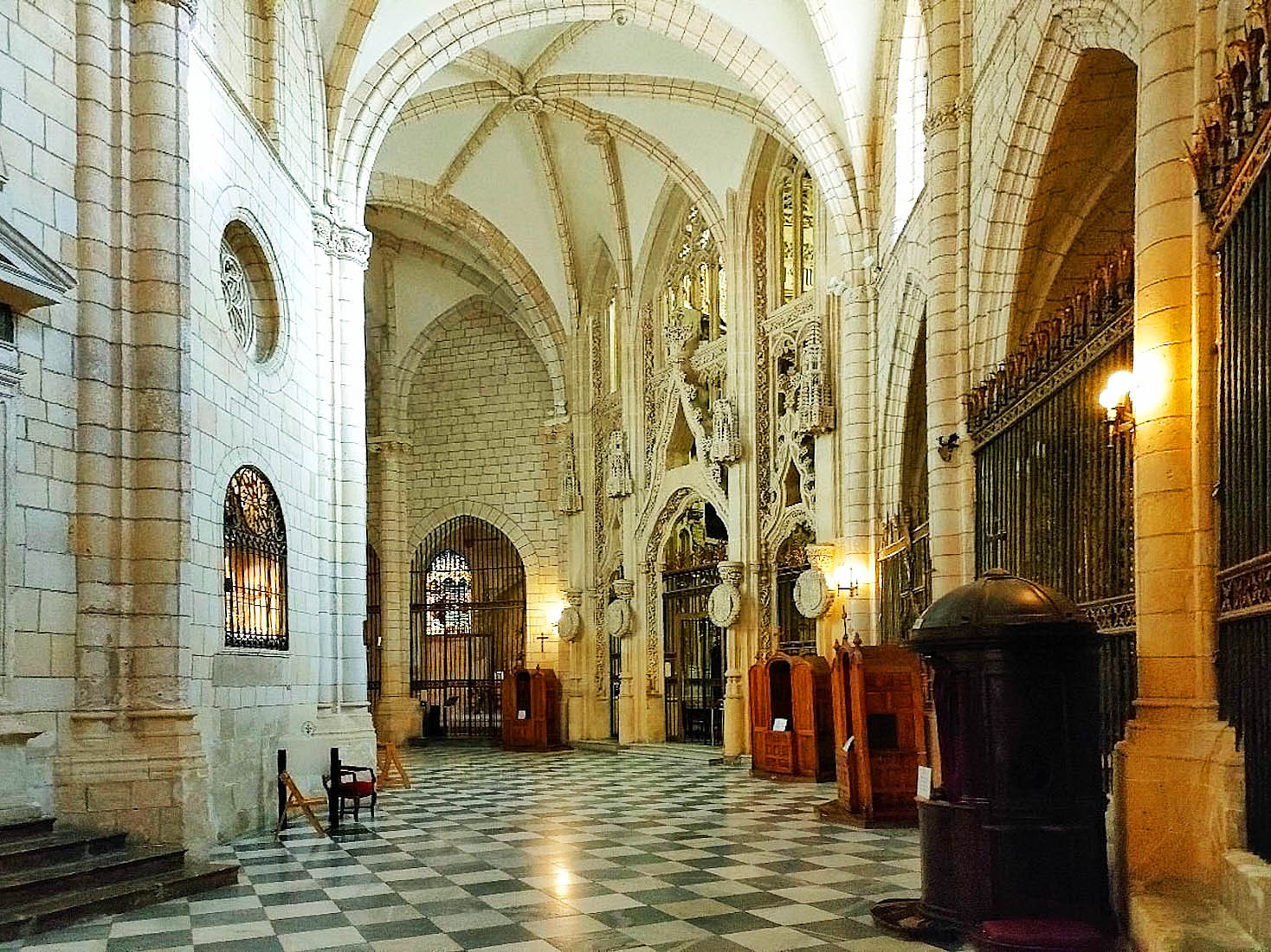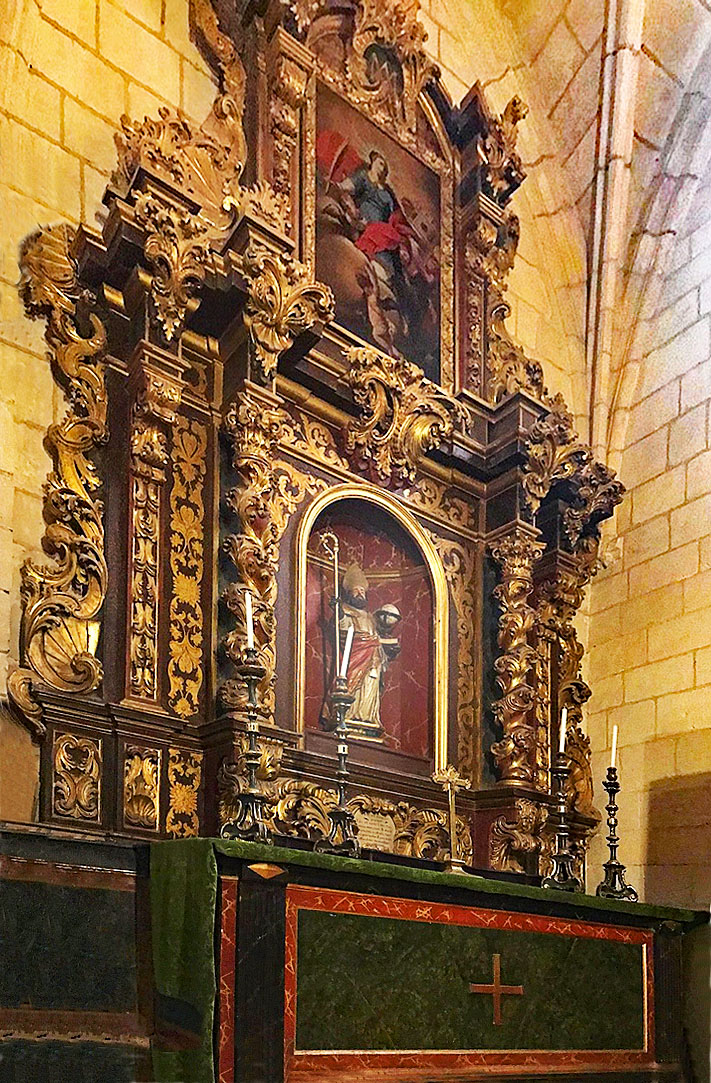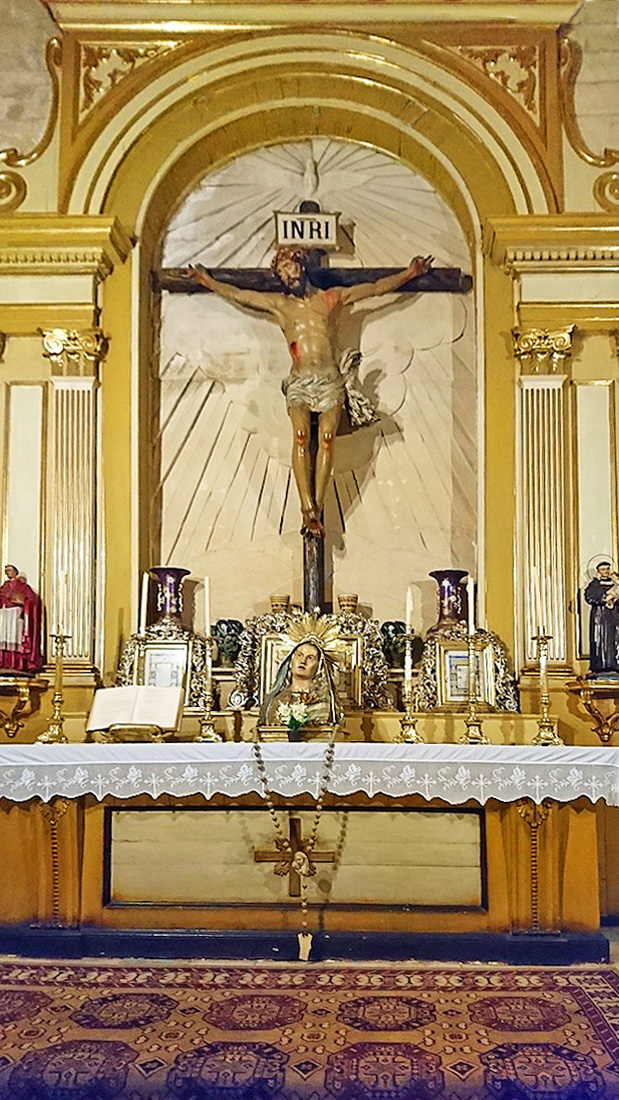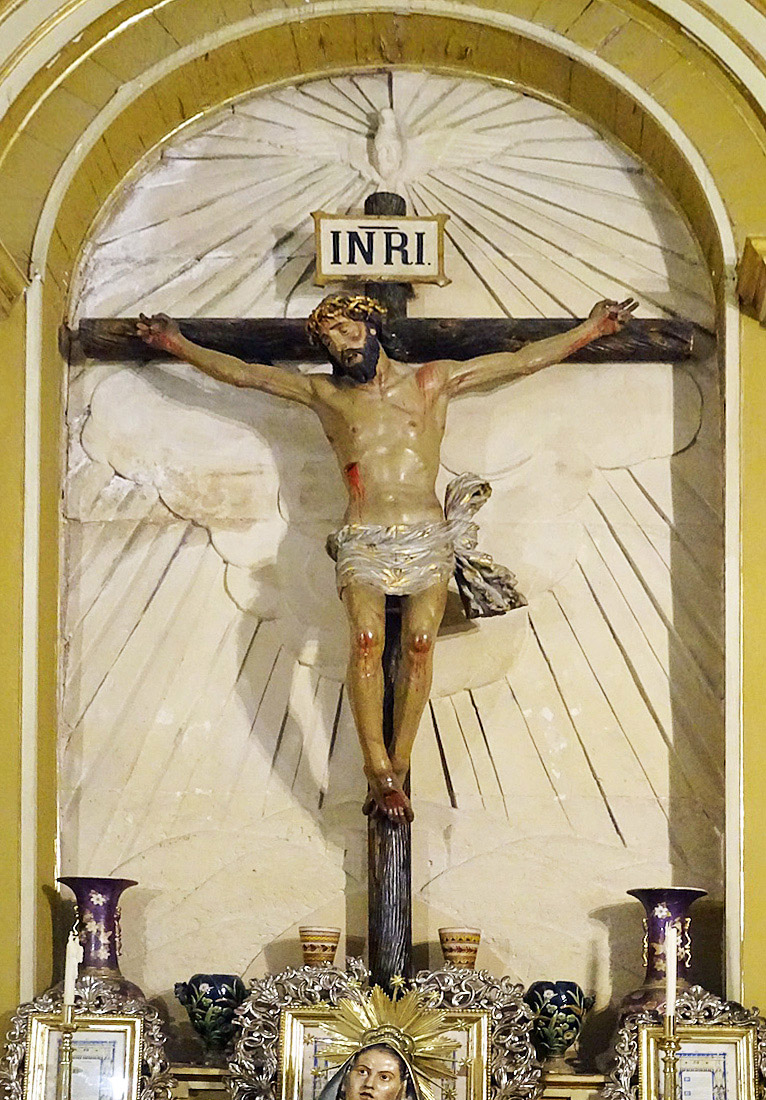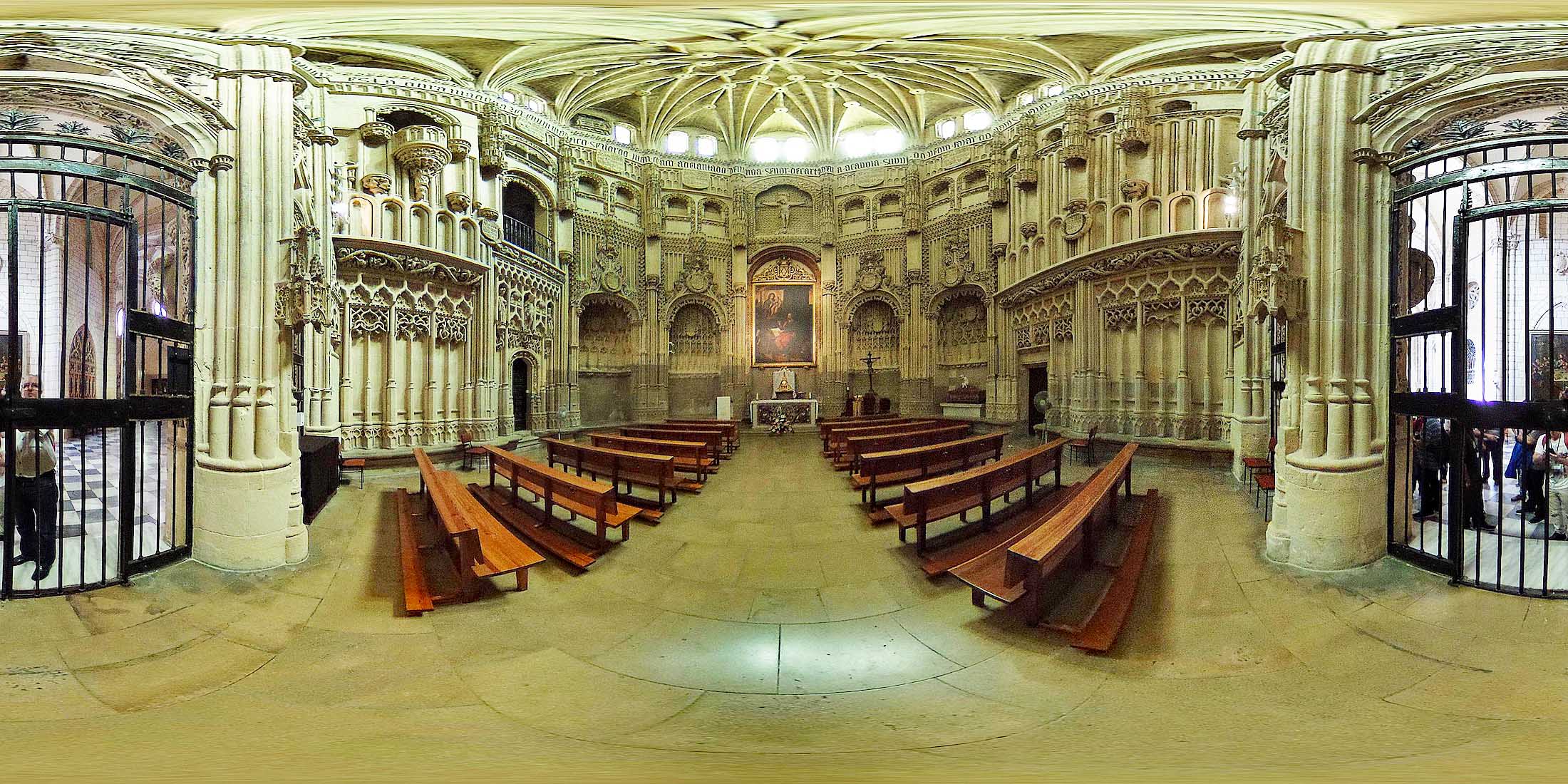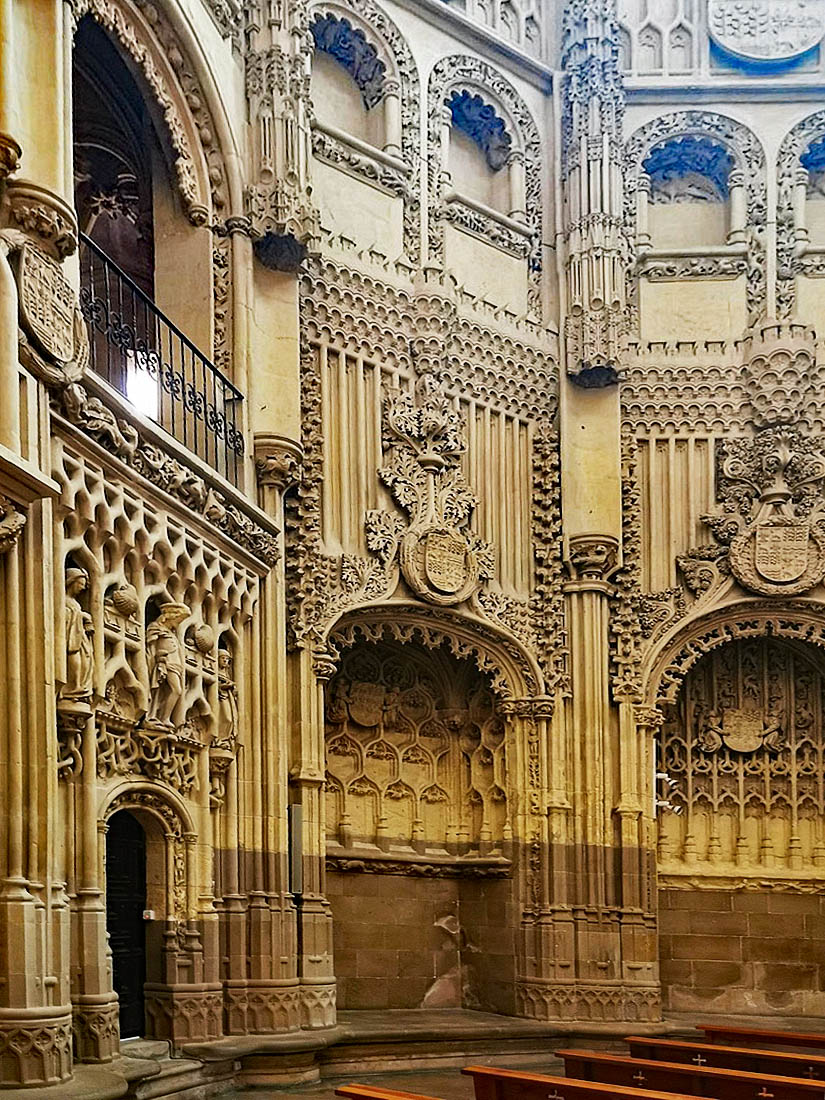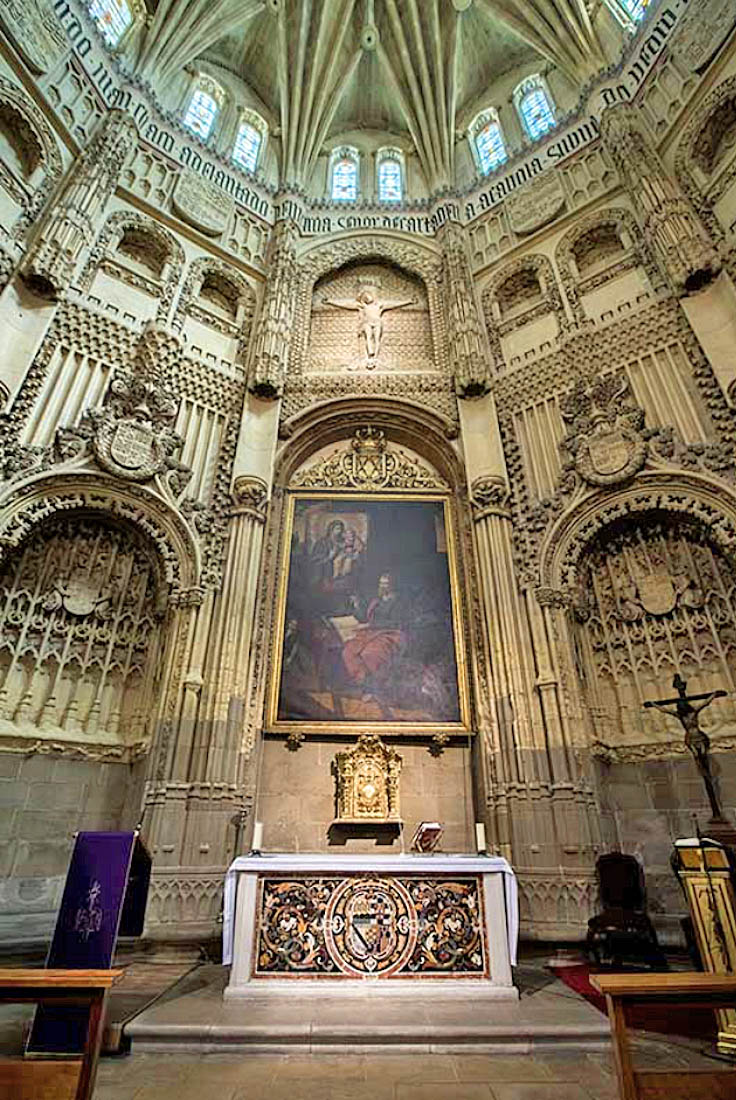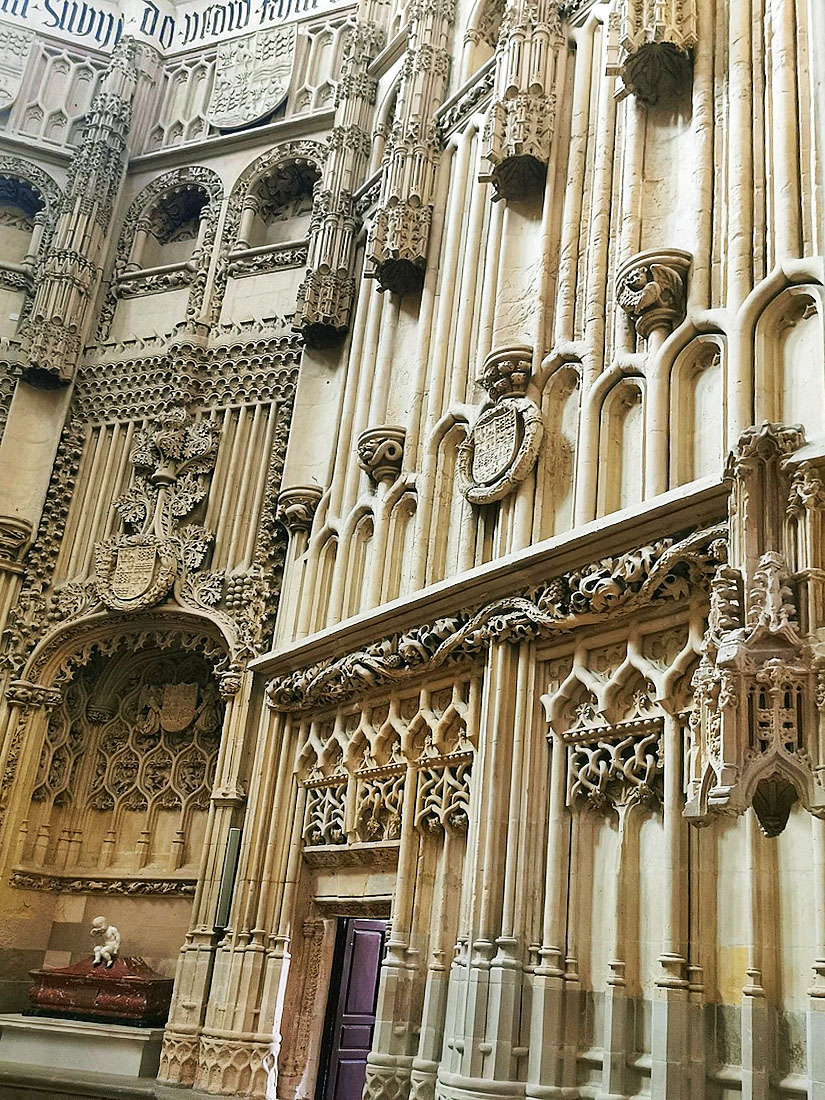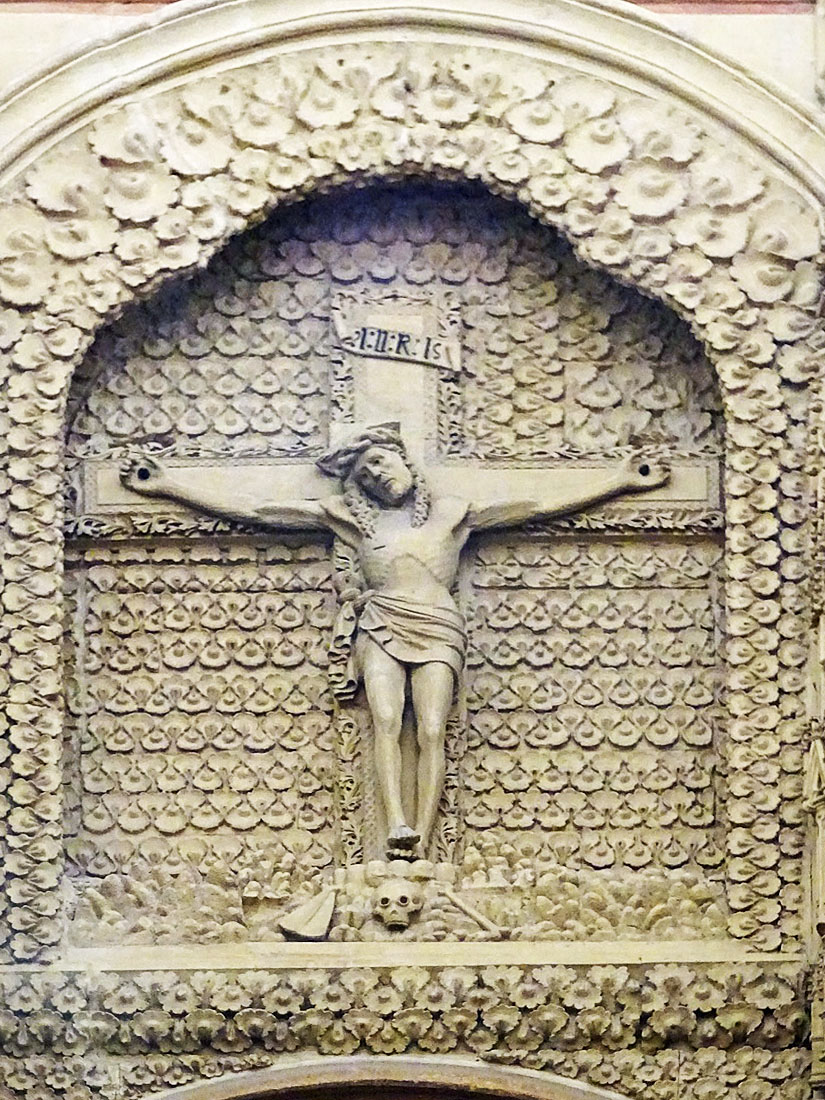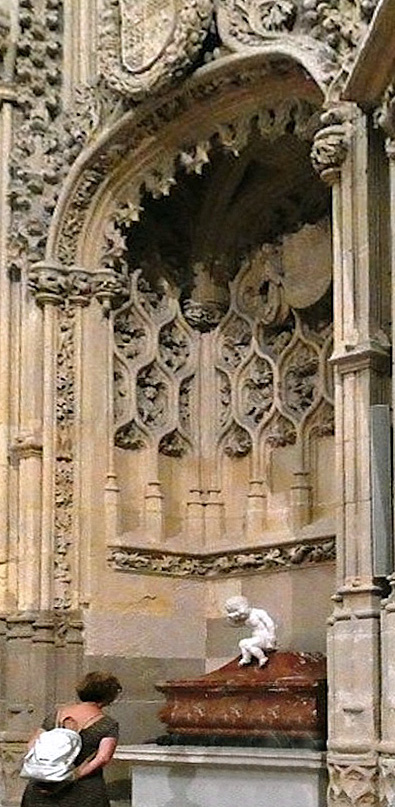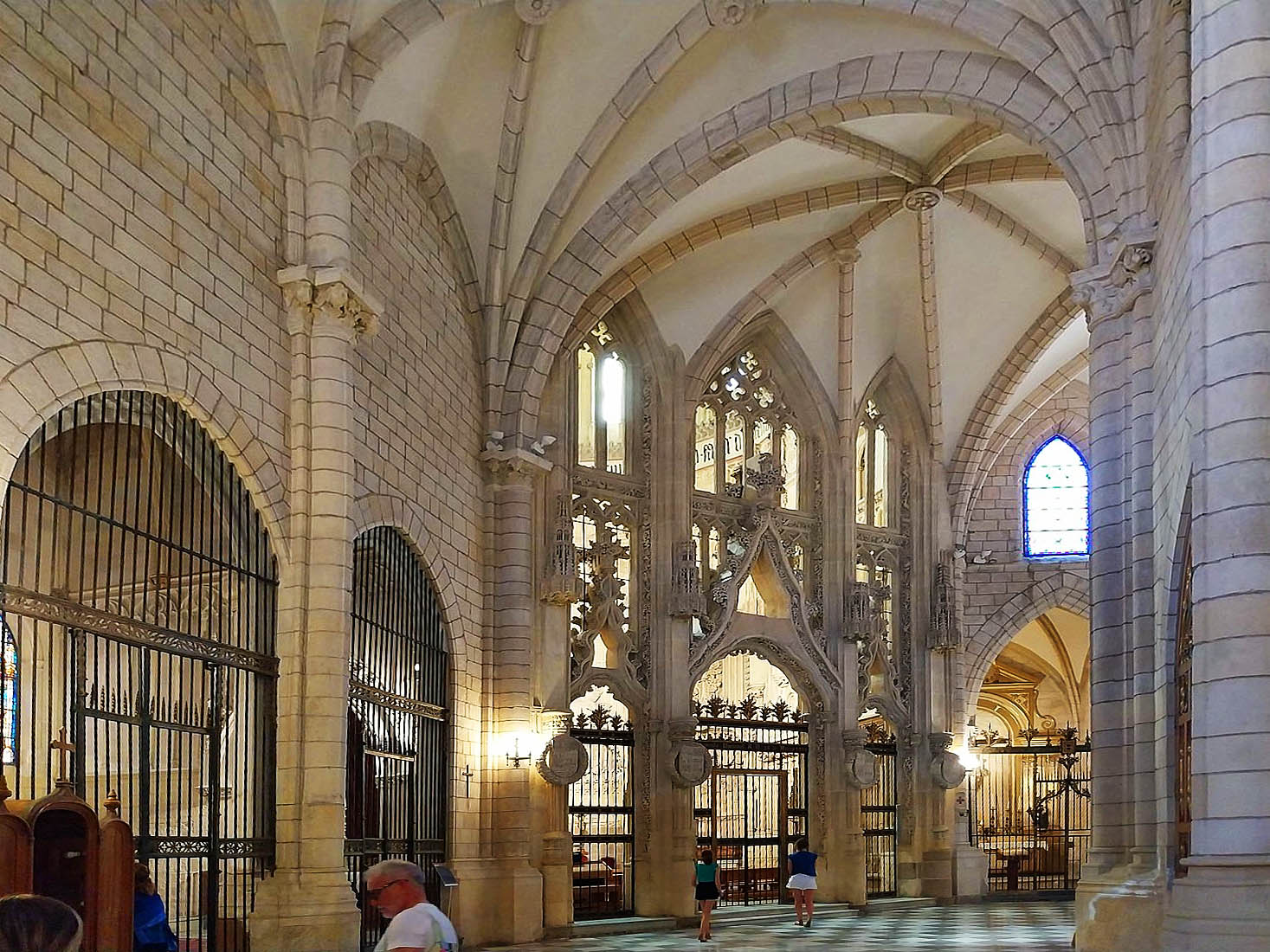

The choir stalls are late Renaissance, and carved in walnut wood. There are also 16th-century plateresque chairs from the Monastery of Santa Maria de Valdeiglesias, which were installed: a donation made by Queen Isabel II to the Cathedral. [Photo1 Credit: petardoino ] INDEX
6–7. NAVE (MAYOR CHAPEL) MC TA TA fjg SS
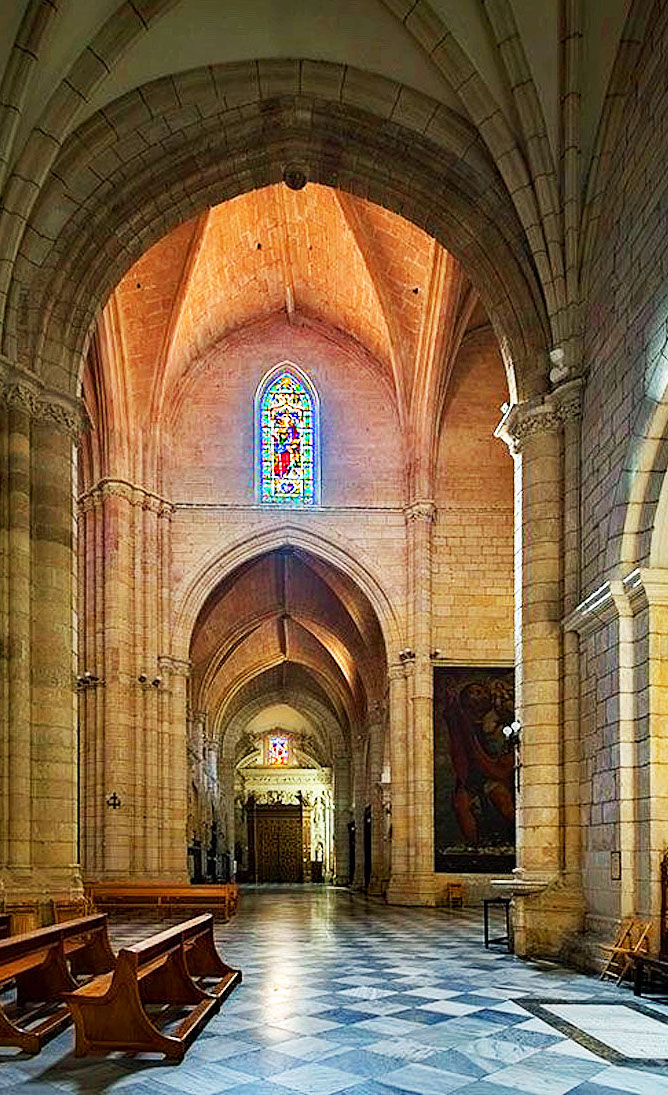
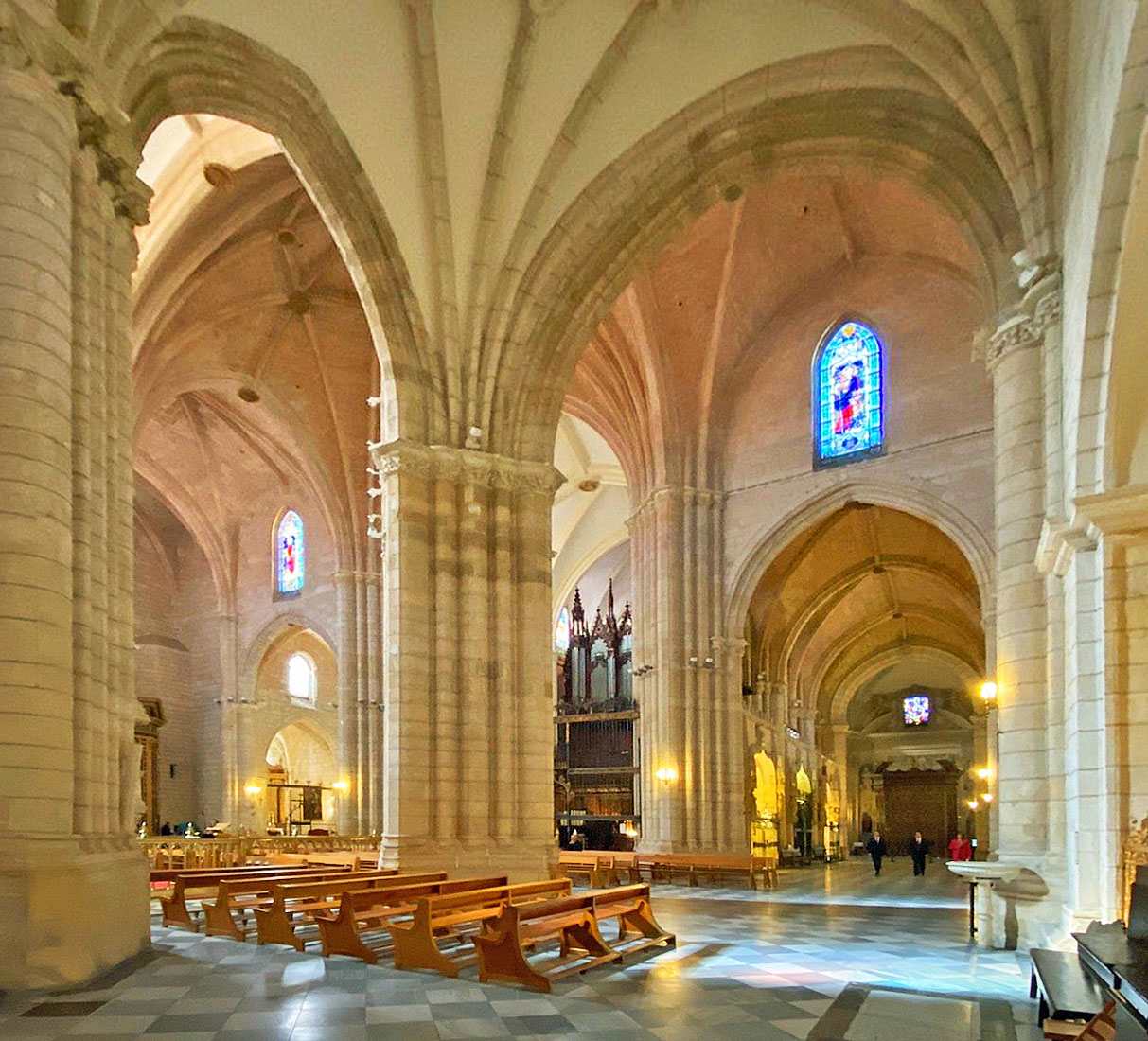
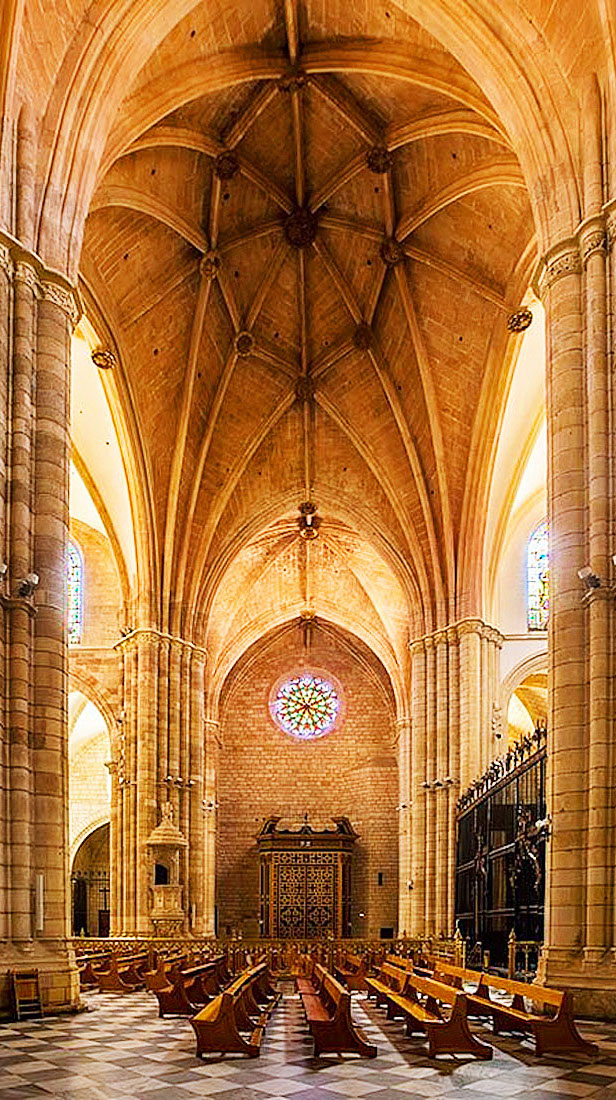

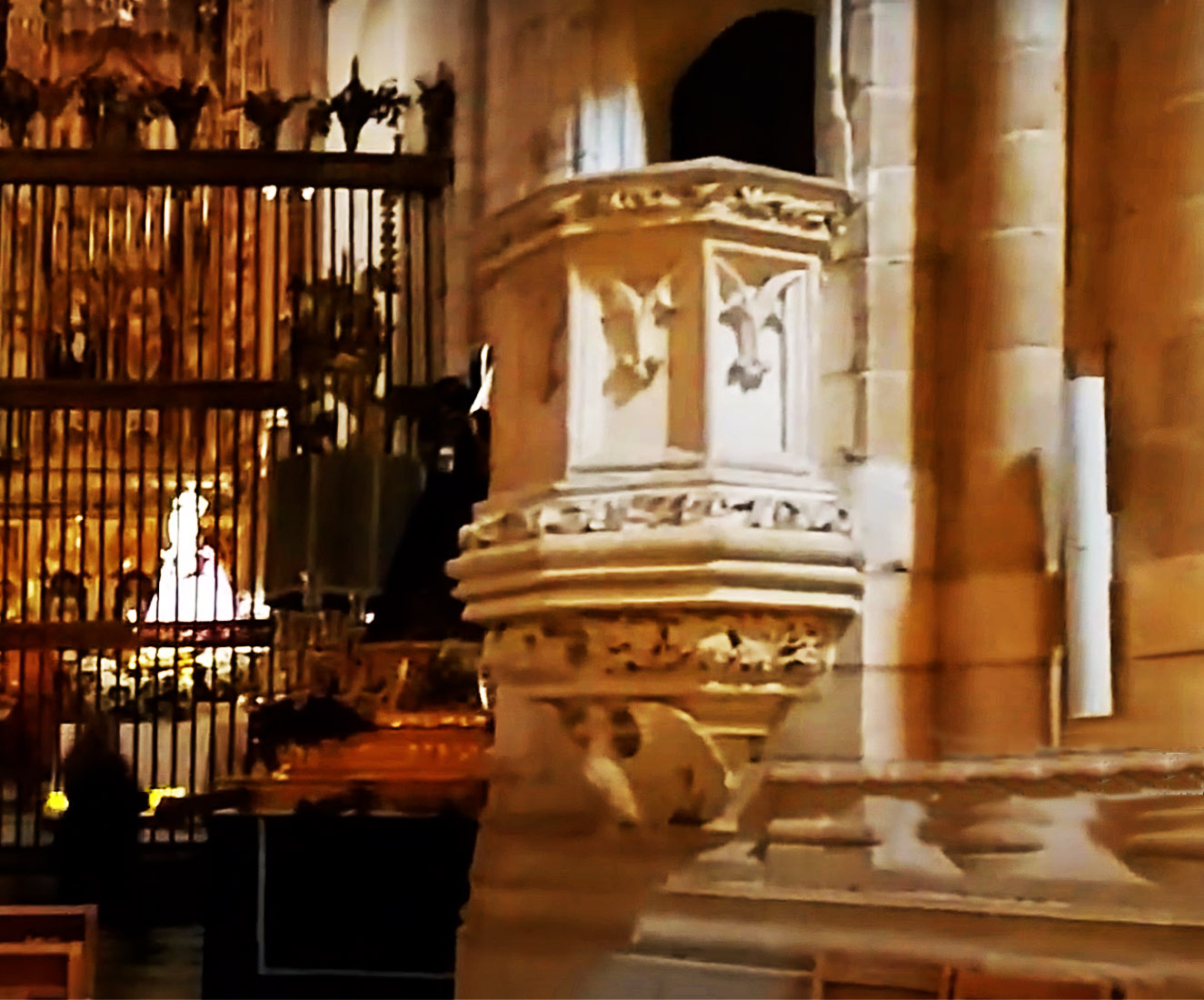
We walk around the nave, taking time to orient ourselves. So in these photos we start looking West down the North aisle, turning left to include the organ, walking forward to view the South transept with its rose window. Here the organ is on our right, and we can see the pulpit which is also pictured close up. •• The beautiful rose window has a botanic theme, but its theological significance is unclear. The window survived the 1854 fire. [Photo2 Credit: Javier Ruiz Martinez ] [Photo3 Credit: Management ]
7. HIGH ALTAR MC TA MC (X3)
Of course the striking feature of the nave is the magnificent altarpiece on the Eastern wall. This was badly damaged in the 1854 fire. The repair works consisted in the creation of this new neo-Gothic altarpiece – work of the sculptors Pescador and Palao. At top centre is a crucifixion scene with saints, bishops and angels crowding the surrounding panels. [Photo2 Credit: Danish Travelor ]
7. HIGH ALTAR MADONNA TA
At the centre of the altarpiece is a niche containing the Madonna, but as seen here, there may be some variation. Pictured at left is Our Lady of Fuensanta, principal patron of the city of Murcia, a title held since the first half of the 18th century. There is a Sanctuary of our Lady of Fuensanta a short distance out of Murcia. [Photo Credit: Management ]
7 – 8. APSE WINDOWS SS fjg
A set of high clerestory windows surrounds the sanctuary and apse. A selection of these is shown here.
7–8. CHRIST FIGURE SS SS
We now leave the high altar and move back towards the South aisle. On the way we pass this darkly clad figure carrying a cross. The back view shows us that this is a float to be carried in one of the Cathedral processions. I have a lasting memory of one such procession, with swaying floats, scary hooded and masked figures, and the hypnotic beat of the drums.
8. CHAPEL OF ST JOHN OF NEPOMUK TA (X3)
Just East of the South transept door is the Chapel of St John of Nepomuk. John of Nepomuk (or John Nepomucene) (c. 1345 – 1393) was a saint of Bohemia (Czech Republic) who was drowned in the Vltava river at the behest of King Wenceslaus IV of Bohemia. Later accounts state that he was the confessor of the queen of Bohemia and refused to divulge the secrets of the confessional. On the basis of this account, John of Nepomuk is considered the first martyr of the Seal of the Confessional, a patron against calumnies and, because of the manner of his death, a protector from floods and drowning. I can find no reference relating him to Murcia. [Photo1 Credit: Jan S ] [Photo2 Credit: Lone S ] [Phoo3 Credit: Vadim ]
8 – 9. TOWARDS THE AMBULATORY TA SS TA
Standing in front of the Chapel of St John, we look East around the ambulatory. On the opposite wall is a grill with a silver casket behind. The tomb of King Alfonso X the Wise sits below the main altar, but I can find no information about this tomb. To our right are three confessionals. The nearest reminds me of a post box. It is unusual and probably quite historic. Notice the chapel details behind this confessional. [Photo1 Credit: Juan D ] [Photo3 Credit: viviamaridi ]
9. CHAPEL OF ST DENIS fjg (X3)
In this Chapel there is a central triptych, and a side altar with a niche containing a Bishop (Denis?). There is also a stained glass window showing the young Virgin Mary being taught to read by her mother St Anne. •• Denis of Paris (Latin: Dionysius) was a 3rd-century Christian martyr and saint. According to his hagiographies, he was bishop of Paris (then Lutetia) in the third century and, together with his companions Rusticus and Eleutherius, was martyred for his faith by decapitation. There is a popular story claiming that the decapitated bishop picked up his head and walked several miles while preaching a sermon on repentance. There is a Basilica of St Denis in Paris.
10. CHAPEL OF CHRIST OF MERCY TA TA
Chapel #10 is the Chapel of Christ of Mercy. On the back wall is Christ on the Cross, and in front is an altar covered with candlesticks and various religious artefacts. [Photos Credit: Abechon_Odekake ]
11. VÉLEZ CHAPEL MC Wiki
We next come to the impressive Vélez Chapel. This Chapel, with its lavish and exuberant décor, is the most important and representative of Murcia Cathedral. It was named a National Monument in 1928. It is a funeral chapel, and was founded in 1490 by Juan Chacón, Governor of the Kingdom of Murcia and finished in 1507 by his son Pedro Fajardo, the first Marquis of Vélez. It is one of only three flamboyant Gothic style funeral chapels in all of Spain. It has an irregular octagonal floor plan, and is covered by extraordinary ten-point star vault. [Photo2 Credit: Galopax ]
11. VÉLEZ CHAPEL WALLS TA MC TA
The chapel stands out from the other chapels in the church, in terms of its size and height, demonstrating the power of its patrons. High on the wall in front of us is a large crucifix, and over the door on the left that leads to the old sacristy, pulpit and balconies, is the image of the Risen Christ with Mary Magdalene and Salome. [Photos1,3 Credit: Vadim ]
11. VÉLEZ CHAPEL DETAILS fjg MC TA
The large central canvas is a work by Francisco García, and dates back to 1607. It shows Saint Luke, to whom this chapel is dedicated. The arches around the base of the front wall were used to house the funeral monuments of the family, but there is only one marble sarcophagus on which a white marble child is sat. A work by Roque López, it cries sadly for the death of the two royal children buried there in 1810. •• Under this floor, and practically occupying the entire area of the chapel, a large brick vault forms the crypt. [Photo3 Credit: ciclope2015 ]
11 – 12. LEAVING THE CHAPEL Wiki SS TA
We leave the Vélez Chapel. Facing the Chapel across the aisle is a painting of The Last Supper. This is likely a version of a painting by Tintoretto. The Last Supper is a significant scene in Christian tradition, portraying Jesus' final meal with his apostles before his crucifixion. The painting captures the moment when Jesus announces that one of them will betray him, as described in the Gospels. [Photo Credit: Diego Delso ] [Photo3 Credit: Jessica B ]


